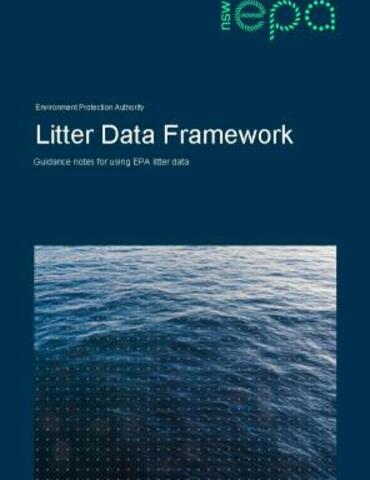Litter data and targets
To effectively prevent litter, you need to understand the litter problem, set targets and track progress over time. Regular research, data collection and monitoring help the EPA ensure NSW's litter prevention strategies are working well to achieve state-wide litter reduction targets.
EPA Litter Data Framework
The EPA Litter Data Framework (PDF 2MB) brings together a range of litter data to provide the information you need to reduce litter in NSW. The Framework includes the National Litter Index and Australian Litter Measure – which count litter on land – and the Key Littered Items Study, which counts litter in urban estuaries.
By incorporating these with other data – including the Local Litter Check, Butt Litter Check and Butt Litter Index – the EPA Litter Data Framework helps create a rich picture of litter in NSW. This covers over 200 different litter types, and their quantities, trends and distribution across different regions.
The data covered in the Framework help provide the evidence needed to plan and evaluate effective litter prevention. The Framework will provide general guidance on how the data relate to one another, and where resources for accessing and using the data can be found.
NSW litter targets
NSW litter reduction targets are outlined in the Waste and Sustainable Materials Strategy 2041 and the NSW Plastics Action Plan. They are:
- target 1: a 30% reduction in plastic litter items by 2025
- target 2: a 60% reduction in all litter items by 2030.
These targets focus on tracking litter loads by density (the number of items per 1,000 square metres), whereas previous NSW targets focused on volume (the number of litres per 1,000 square metres). This report gives details of both density and volume.
Note: the former Premier’s Priority target to reduce litter volume by 40% by 2020 was achieved with a 43% reduction in litter volume from the baseline year 2013–14. With volume now substantially reduced, the NSW Government has set item‑based targets to ensure a renewed focus on small, problematic litter items that are more likely to leak into the environment and waterways.
Land versus marine litter counts
The NSW litter data framework uses a range of data to inform litter programs. Up to 2020 the EPA relied on the National Littered Index (NLI), a land-based litter measure. The Key Littered Items Study (KLIS) is now the key monitoring program.
KLIS counts litter in urban estuaries, collecting samples from mangroves that act as natural litter traps and that generally have a higher concentration of litter than nearby urban areas. KLIS can provide richer detail on litter than the NLI, and a fuller picture of loads and composition.
The Australia Litter Measure replaced the NLI as a new land-based count of litter from 2022 onwards. It has been designed to be more easily related to the estuarine litter data that the KLIS samples, and to provide a fuller understanding of the movement of litter from land to sea.
Baseline
The figure below shows the composition of litter in the baseline years, using aggregated categories, that is, items grouped together based on how they are used and consumed.
Litter reduction baseline and targets
| Target | Baseline (2018 + 2019) | Target value |
|---|---|---|
| 30% reduction in plastic litter items by 2025 | 158 items per 1,000m2 | 111 items per 1,000m2 (by 2024–25) |
| 60% reduction in all litter items by 2030 | 190 items per 1,000m2 | 76 items per 1,000m2 (by 2029–30) |
The Key Littered Items Study
The Key Littered Items Study (KLIS) is a long-term monitoring program that shows which types and quantities of litter can be found in NSW coastal and marine waters. It is the main dataset used to track progress to the NSW Litter targets.
The KLIS started in 2017 and surveys are conducted quarterly. The KLIS monitoring sites are:
- in mangroves in urban estuaries
- on some remote beaches.
The sites span the full length of the NSW coast.
KLIS data is collected by the Department of Planning and Environment’s Coastal and Marine Science Division. It is entered into an EPA dashboard and analysed by the EPA Litter Prevention Unit.
KLIS reports are published annually to do the following:
- show progress towards targets
- inform litter prevention program and policy responses.
Over time, the KLIS will be used together with other litter data, such as the Australian Litter Measure, to build a detailed picture of trends.
More information on KLIS and other litter data is available in the NSW Litter Data Framework and on the Department of Environment and Planning’s Key Littered Items Study webpage.
Video
The EPA and the Department of Planning and Environment have created a video showcasing the sophisticated KLIS litter count. It demonstrates how the KLIS is structured and organised, including how the data and litter items are collected on site and how it is sorted and categorised at the sorting warehouse. It highlights the current top littered items and emerging litter items found in the environment.
This video shows how our programs are designed to target the key littered items and supports the work we are doing to achieve the new NSW litter reduction targets outlined in the Waste and Sustainable Materials Strategy 2041 and the NSW Plastics Action Plan.
Download

Litter data framework Litter data framework
